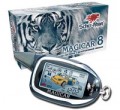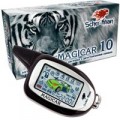Functions
—
Service mode (Valet). A special mode of operation in which all signals and warnings are turned off, however (in some models) the ability to control car locks through the alarm remains. This function is convenient when using the services of service stations, car washes and other services, when completely “legal” effects on the car can be perceived by the alarm system as signs of intrusion and cause false alarms. When the system is in Valet mode, the driver does not have to leave the control key fob to the service centre personnel, which minimizes the possibility of signal scanning.
—
Management of a regular key fob. The ability to control alarm functions using a standard key or vehicle key fob.
Modern cars and other vehicles are equipped with more and more complex electronic systems, and to control these systems, a regular key or key fob is often used. The same key/trinket can be used to control the car alarm. Of course, the specific functionality of such models can be different, it's ok to clarify it separately. The same applies to the compatibility of the signaling with a specific key or key fob — different manufacturers may use different communication standards, and it will not hurt to clarify the support of this standard by the selected "signaling" separately.
The main advantages of this function are, first of all, that it reduces the number of key fobs used to control the functions of t
...he car, and at the same time allows you to use all the "chips" of standard key fobs / keys that were originally provided by the manufacturer. In addition, branded key fobs and keys are purely subjectively liked by many drivers due to the presence of symbols of a particular car brand.
— Management of windows. Possibility to control the windows of the car through the car alarm. Thanks to this function, the driver can raise and lower the windows of the car remotely, from a key fob or other control device. This feature can be useful, for example, if the car is already closed, but the windows are not fully raised: instead of disarming the car and getting to the power window control buttons, you can simply give a command from the key fob.
— Management of the opening of the boot. The ability to control the opening of the boot of the car through a car alarm, from a key fob or other control device. This function, usually, allows you to open and close the boot without disarming the doors (and other areas of the car) and without entering the passenger compartment. This is more convenient, and sometimes even safer, than working with the boot in the usual way.
— Locking doors when driving. Possibility of automatic locking of car doors at the beginning of the movement. This feature reduces the risk of a car being seized by force when intruders get into the passenger compartment by simply opening unlocked doors — for example, while stopping at a traffic light. Of course, the central lock can be closed from the driver's seat and manually; however, you can forget about it, while automatic closing works without driver intervention.
— Panic mode. The presence of the "Panic" mode in the alarm system allows the driver to manually turn on the alarm — with a siren, light signals, engine blocking, etc. This feature can be useful if the driver sees suspicious people at his car — in order to frighten off potential hijackers — as well as in other situations when you need to draw the attention of others to the car. In addition, in the absence of the "Search for a car" function (see below), a short-term activation of the "Panic" mode can play its role.
— Function "Polite backlight". Alarms with the function of "polite lighting" are able to control the interior lighting, providing the driver and passengers with additional comfort. For example, when the doors are opened, the lighting can turn on, facilitating placement and orientation in the cabin, and when you start moving and close the doors with the ignition off, it can go out. Turning the light on and off is often done smoothly, avoiding abrupt transitions and making it easier for the eyes to get used to it.
— "Take me home" feature. With this function, the alarm can control the headlights so that they (when the engine is turned off) do not turn off immediately, but after some time after pressing the switch and closing the door. Thus, you can use car headlights to illuminate at night — for example, if you need to walk from the car to the entrance in a dark courtyard on uneven asphalt. The time for turning off the “seeing off” headlights is most often about half a minute — this, usually, is quite enough for the purposes described.
— Function "Search vehicle". This function consists in the fact that, at the command from the key fob, the alarm system gives several short signals (light or sound, and in silent security mode — only light), signaling the driver about the location of the car or motorcycle. This can be useful, for example, in a large parking lot of a hypermarket or an entertainment complex, where the vehicle can get lost among other cars, and searching for it “manually” (especially if you need to carry purchases or roll a cart at this time) can be quite tedious.
— Hands Free function (label). This function allows the driver to control the alarm without using the key fob. A special tag is responsible for managing the operating mode, which the driver needs to carry with him, and a sensor system that responds to the approach and distance of the tag. Thus, when a person with a tag moves away from the car at a certain distance, the alarm is automatically armed, and, having noticed the appearance of a tag within the range of the sensors, it is removed. This format of work allows the driver to keep his hands free and not be distracted by the key fob; in addition, communication between the system and the tag is minimal, making scanning nearly impossible.
— Autostart on the voltage of the onboard network. Possibility of using an alarm to automatically start the engine in case of a significant drop in battery voltage. This situation may arise, in particular, when the car is idle for a long time, especially in cold weather. A dead battery is not only fraught with problems when starting a car: car alarms are often powered from it, so when the charge is exhausted, the car can be left unguarded. To avoid this, this possibility is provided: having fixed a voltage drop close to critical, the alarm starts the engine for a while, recharging the battery from the auto generator and preventing the described troubles. It should be noted that the use of this function is associated with certain restrictions and precautions; for more details about them, see above, in the paragraph “Autostart by temperature”.
— Function "call the driver". This feature allows a person at or inside the car to signal a call to the driver's key fob. Note that the call button is most often installed in the cabin, based on passengers; however, an external location may also be provided, allowing the driver to be called even with the car closed. In the latter case, the installation location of the call sensor is usually marked with a sticker with the appropriate inscription, for example, “Knock three times to call the driver”; and the call method is chosen in such a way that the alarm system can clearly distinguish it from an attempted opening or accidental impact on the car. However, this feature is only found on models with two-way communication (see "Communication Type"). In this case, we are talking about a separate call signal, and not about a general alarm signal, which allows the driver to more accurately assess the situation (and saves his nerves). “Calling the driver” can come in handy, for example, in a situation where the passenger remaining in the car felt unwell, or if the car had to be put in such a way that it blocks the exit of other vehicles. In the latter case, conscientious drivers leave a note with a mobile phone number on the glass, but with this function, you can do without a note — the main thing is that the range of the key fob is enough.
— Bluetooth Smart. This function allows the user to use a smartphone with a special application as a key fob to access the car. At the same time, in accordance with the name, communication is carried out via Bluetooth, due to which such authentication works even in the absence of mobile communication (for example, in an underground garage). The convenience of such alarm control is obvious: you do not need to carry an additional item (keychain or tag) with you, and the probability of forgetting your smartphone somewhere is much lower than the probability of not taking the same keychain with you. At the same time, the probability of interception of the control signal, according to the manufacturers, is practically zero. And in some models, owner authentication and disarming can be carried out completely automatically when the smartphone approaches a certain distance. Other functions (such as transmission of diagnostic data) can also be implemented via Bluetooth Smart, depending on the model. The main disadvantage is that Bluetooth Smart alarms are very expensive. In addition, this technology is far from compatible with every smartphone, this point needs to be specified separately.
— Diagnostics of malfunctions. The ability to use alarms to diagnose various failures and malfunctions. In different models, the implementation and capabilities of this function may be different. Most often, this function involves at least self-diagnosis: the alarm “interrogates” the sensors with service signals and, if one of them fails, notifies the user about this. However, more extensive possibilities may also be provided — such as obtaining data from the car's own sensors (for example, about a decrease or complete disappearance of battery voltage). This not only allows you to monitor the technical condition of the car, but also provides additional security — for example, a decrease in the level of gasoline in the tank may be a sign that it is being drained.battery and fuel indication
Possibility to display data on the key fob about the
level of charge of the battery(ACB) and the amount of fuel in the car tank.
For obvious reasons, this function is found only in models with the possibility of two-way communication (see "Type of communication"). It greatly facilitates monitoring the state of the car: checking the energy and fuel reserves on the key fob is much easier, more convenient, and sometimes safer than going to the car for this, starting the engine and getting acquainted with the data on the dashboard. And in some cases, such an opportunity can even warn of an intrusion (for example, if someone tries to drain the gas from the tank, having managed not to trigger the alarm). At the same time, we note that for the normal operation of this function, the car itself must have certain equipment; therefore, before buying a "signal" with this function, it's ok to make sure that it can work normally on your car.
Non-volatile memory
The presence of non-volatile memory in the design of car alarms. The term "non-volatile" means that such a memory retains the content written to it even when the power is turned off. Thus, alarms with this function are able to save the specified settings even if the power is turned off. This allows, for example, leaving the car in the garage with the battery terminal removed, without fear that the settings will “fly off” in the alarm system (such as data on the arming delay, see “Security and Protection”).

